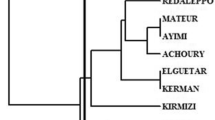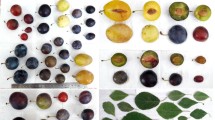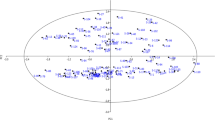Abstract
Fruit quality attributes were studied for two consecutive years in forty-three apricot cultivars and selections grown in a Mediterranean climate. Physical parameters (weight, size, flesh and skin colour, percentage of blush, firmness and percentage of dry matter), chemical parameters (total soluble solids content and acidity) and sensory parameters (attractiveness, taste, aroma and texture) were evaluated. A high variability was found in the set of the evaluated apricot genotypes and significant differences were found among them in all studied quality attributes. Year-by-year variations were observed for some pomological traits such as harvest date, flesh colour, fruit weight, firmness and soluble solids content. A high correlation was found among some apricot quality attributes. In addition, principal component analysis (PCA) made it possible to establish similar groups of genotypes depending on their quality characteristics as well as to study relationships among pomological traits in the set of apricot genotypes evaluated.

Similar content being viewed by others
References
Abbott JA (1999) Quality measurement of fruits and vegetables. Postharvest Biol Technol 15:207–225
AOAC (1984) Official methods of analysis, 14th edn. Association of Official Analytical Chemists, Arlington, VA, pp 414–420
Asma BM, Ozturk K (2005) Analysis of morphological, pomological and yield characteristics of some apricot germplasm in Turkey. Genet Resour Crop Evol 52:305–313
Audergon JM, Souty M, Breuils L (1990) Amélioration génétique pour l’obtention d’abricots de qualité. In 9° Colloque sur les recherches fruitières. Avignon 4-5-6 décembre 1990. Ctifl-INRA, pp 217–228
Audergon JM, Reich M, Souty M (1991) Abricot. Les variations des critères de qualité. L’Arboriculture fruitière 436:35–46
Azodanlou R, Darbellay C, Luisier JL, Villettaz JC, Amadò R (2003) Development of a model for quality assessment of tomatoes and apricots. Food Sci Technol 36:223–233
Badenes ML, Martínez-Calvo J, Llácer G (1998) Analysis of apricot germplasm from the european ecogeographical group. Euphytica 102:93–99
Bailey CH, Hough LF (1975) Apricots. In: Janick J, Moore JN (eds) Advances in fruit breeding. Purdue University Press, West Lafayette, Indiana, pp 367–383
Bassi D, Selli R (1990) Evaluation of fruit quality in peach and apricot. Adv Hort Sci 4:107–112
Bassi D, Bartolozzi F (1993) Il miglioramento genetico dell’albicocco: obiettive e strategie. Rivista di Frutticoltura 5:41–50
Biondi G, Pratella GC, Bassi R (1991) Maturity indexes as a function of quality in apricot harvesting. Acta Hort 293:667–674
Brooks SJ, Moore JN, Murphy JB (1993) Quantitative and qualitative changes in sugar content of peach genotypes (Prunus persica (L.) Batsch.). J Am Soc Hort Sci 118:97–100
Brown GS, Walker TD (1990) Indicators of maturity in apricots using biplot multivariate analysis. J Sci Food Agric 53:321–331
Byrne DH, Nikolic AN, Burns E (1991) Variability in sugars, acids, firmness, and color characteristics of 12 peach genotypes. J Am Soc Hort Sci 116:1004–1006
Byrne DH, Littleton TG (1989) Characterization of isozyme variability in apricots. J Am Soc Hort Sci 114:674–678
Colaric M, Veberic R, Stampar F, Hudina M (2005) Evaluation of peach and nectarine fruit quality and correlations between sensory and chemical attributes. J Sci Food Agric 85:2611–2616
Crisosto CH, Garner D, Crisosto GM, Bowerman E (2004) Increasing ‘Blackamber’ plum (Prunus salicina Lindell) consumer acceptance. Postharvest Biol Technol 34:237–244
Crisosto CH, Crisosto GM (2005) Relationship between ripe soluble solids concentration (RSSC) and consumer acceptance of high and low acid melting flesh peach and nectarine (Prunus persica (L.) Batsch) cultivars. Postharvest Biol Technol 38:239–246
Crossa-Raynaud P, Audergon JM (1991) Some reflexions on apricot selections. Acta Hort 293:73–85
Egea J, García JE, Berenguer T (1994) Variedades de albaricoquero. Hortofruticultura 6:56–62
Egea J, Martínez-Gómez P, Almansa MS, Contreras E (1997) Influencia de la recolección prematura en la calidad del fruto de variedades de albaricoquero de maduración precoz: resultados preliminares. ITEA 93:81–93
Egea J, Dicenta F, Burgos L (2004a) Rojo Pasión apricot. HortScience 39:1490–1491
Egea J, Martínez-Gómez P, Dicenta F, Burgos L (2004b) Selene apricot. HortScience 39:1492–1493
Egea J, Ruiz D, Dicenta F, Burgos L (2005a) Murciana apricot. HortScience 40:254–255
Egea J, Ruiz D, Burgos L (2005b) Dorada apricot. HortScience 40:1919–1920
Egea J, Romojaro F, Pretel MT, Martinez-Madrid MC, Costell E, Cascales A (2006) Application of sensory analysis to the determination of the determination of the optimum quality and harvesting moment in apricots. Acta Hort 701:529–532
Esti M, Messia MC, Sinesio F, Nicotra A, Conte L (1997) Quality evaluation of peaches and nectarines by electrochemical and multivariate analyses: relationships between analytical measurements and sensory attributes. Food Chem 60:659–666
FAO (2005) Los datos de Faostat 2005. http://www.faostat.fao.org
Génard M, Bruchou C (1992) Multivariate analysis of within-tree factors accounting for the variation of peach fruit quality. Sci Hort 52:37–51
Génard M, Souty M, Holmes S, Reich M, Breuils L (1994) Correlation among quality parameters of peach fruit. J Sci Food Agric 66:241–245
González AR, Mauromoustakos A, Prokalis G (1992) Influence of year, cultivar and fruit maturity on quality of peach puree. J Food Quality 15:97–109
Gurrieri F, Audergon JM, Albagnac G, Reich M (2001) Soluble sugars and carboxylic acids in ripe apricot fruit as parameters for distinguishing different cultivars. Euphytica 117:183–189
Hagen LS, Khadari B, Lambert P, Audergon JM (2002) Genetic diversity in apricot revealed by AFLP markers. Species and cultivar comparisons. Theor Appl Genet 105:298–305
Hilling KW, Iezzoni A (1988) Multivariate analysis in a sour cherry germplasm collection. J Am Soc Hort Sci 113:928–934
Hormaza JI (2002) Molecular characterization and similarity relationships among apricot genotypes using simple sequence repeats. Theor Appl Genet 104:321–328
Iezzoni AF, Pritts MP (1991) Applications of principal component analysis to horticultural research. HortScience 26:334–338
Kramer A, Twigg BA (1966) Fundamentals of quality control for the food industry, 2nd edn. Avi Publishing, Westport, CT
Ledbetter CA, Gómez E, Burgos L, Peterson S (1996) Evaluation of fruit quality of apricot cultivars and selections. J Tree Fruit Prod 1:73–86
Lewallen KS, Marini RP (2003) Relationship between flesh firmness and ground color in peach as influenced by light and canopy position. J Am Soc Hort Sci 128:163–170
Lozano JE, Ibarz A (1997) Colour changes in concentrated fruit pulp during heating at high temperatures. J Food Eng 31:365–373
McGuire RG (1992) Reporting of objective color measurements. HortScience 27:1254–1255
Mehlenbacher SA, Cociu V, Hough LF (1991) Apricots (Prunus). In: Moore JN, Ballington JR (eds) Genetic resources of temperate fruit and nut crops. International Society for Horticultural Science, Wageningen, pp 65–107
Moreau-Rio M, Roty C (1998) L’abricot: Perceptions et attentes des consommateurs français. Ctifl-Infos 141:16–21
Okut H, Akca Y (1995) Study to determine the causal relations between fruit weight and certain important fruit characteristics with using a path analysis. Acta Hort 384:97–102
Parolari G, Virgili R, Bolzoni L (1992) Analysis of sensory and instrumental data on apricot purees with pattern recognition techniques. Analítica Chimica Acta 259:257–265
Perez-Gonzalez S (1992) Associations among morphological and phenological characters representing apricot germplasm in Central Mexico. J Am Soc Hort Sci 117:486–490
Perez-Gonzalez S, Montes S, Mejía C (1993) Analysis of peach germplasm in Mexico. J Am Soc Hort Sci 118:519–524
Ruiz D, Egea J, Tomás-Barberán FA Gil MI (2005) Carotenoids from new apricot (Prunus armeniaca L.) varieties and their relationship with flesh and skin color. J Agric Food Chem 53:6368–6374
Scandella D, Sibille I, Venien S, Lichou J, Jay M (1998) Abricot: Evaluation des atouts organoleptiques. Infos-Ctifl 141:22–25
Souty M, Audergon JM, Chambroy Y (1990) Abricot: les critères de qualité. L’Arboriculture fruitière 430:16–24
Witherspoon JM, Jackson JF (1996) Analysis of fresh and dried apricot. In: Linskens HF, Jackson JF (eds) Modern methods of plant analysis, vol 18. Fruit analysis Springer-Verlag, Berlin, Heidelberg, pp 111–131
Witherspoon JM (1999) Apricot breeding in Australia. Acta Hort 488:253–255
Wu B, Quilot B, Kervella J, Génard M, Li S (2003) Analysis of genotypic variation of sugar and acid contents in peaches and nectarines through the principle component analysis. Euphytica 132:375–384
Acknowledgements
The authors are grateful to Spanish CICYT (Comisión Interministerial de Ciencia y Tecnología) Projects AGL2004-04126-C02-01 for financial support. We wish to thank A. Martínez Adsuar, for technical assistance, Dr. David J. Walker (IMIDA, Murcia), for his critical review of the manuscript, and the MEC, for financially assisting Dr. Ruiz.
Author information
Authors and Affiliations
Corresponding author
Rights and permissions
About this article
Cite this article
Ruiz, D., Egea, J. Phenotypic diversity and relationships of fruit quality traits in apricot (Prunus armeniaca L.) germplasm. Euphytica 163, 143–158 (2008). https://doi.org/10.1007/s10681-007-9640-y
Received:
Accepted:
Published:
Issue Date:
DOI: https://doi.org/10.1007/s10681-007-9640-y




